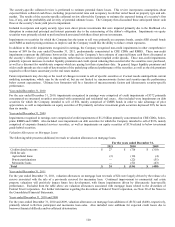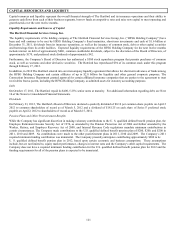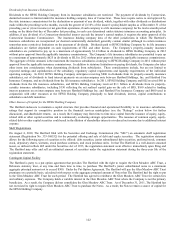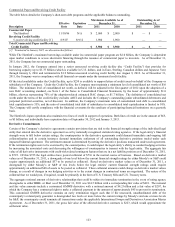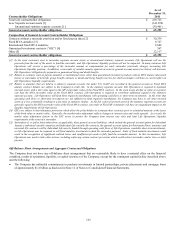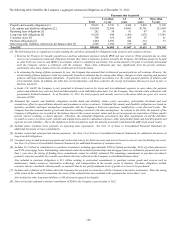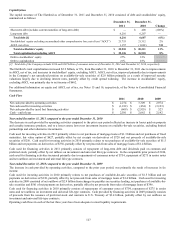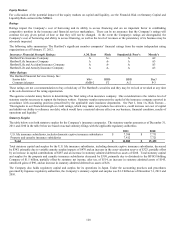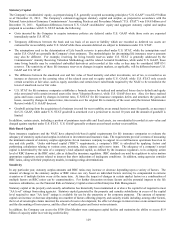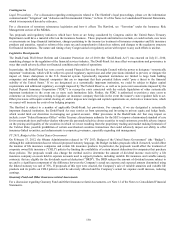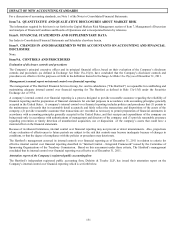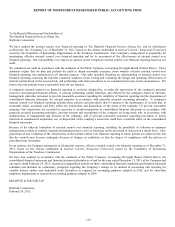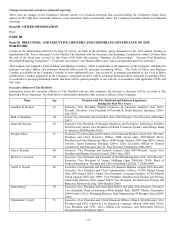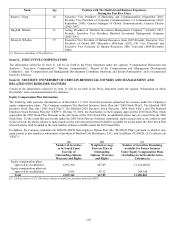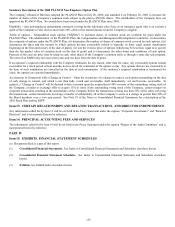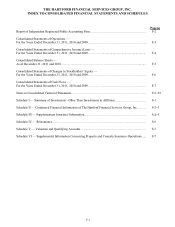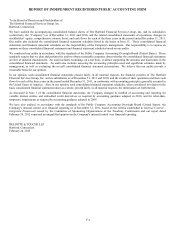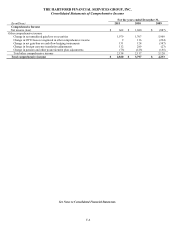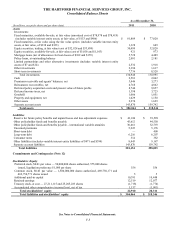The Hartford 2011 Annual Report Download - page 130
Download and view the complete annual report
Please find page 130 of the 2011 The Hartford annual report below. You can navigate through the pages in the report by either clicking on the pages listed below, or by using the keyword search tool below to find specific information within the annual report.130
Contingencies
Legal Proceedings – For a discussion regarding contingencies related to The Hartford’ s legal proceedings, please see the information
contained under “Litigation” and “Asbestos and Environmental Claims,” in Note 12 of the Notes to Consolidated Financial Statements,
which is incorporated herein by reference.
For a discussion of terrorism reinsurance legislation and how it affects The Hartford, see “Terrorism” under the Insurance Risk
Management section of the MD&A.
Tax proposals and regulatory initiatives which have been or are being considered by Congress and/or the United States Treasury
Department could have a material effect on the insurance business. These proposals and initiatives include, or could include, new taxes
or assessments on large financial institutions, changes pertaining to the income tax treatment of insurance companies and life insurance
products and annuities, repeal or reform of the estate tax and comprehensive federal tax reform, and changes to the regulatory structure
for financial institutions. The nature and timing of any Congressional or regulatory action with respect to any such efforts is unclear.
Legislative Developments
The Dodd-Frank Wall Street Reform and Consumer Protection Act of 2010 (the “Dodd-Frank Act”) was enacted on July 21, 2010,
mandating changes to the regulation of the financial services industry. The Dodd-Frank Act may affect our operations and governance in
ways that could adversely affect our financial condition and results of operations.
In particular, the Dodd-Frank Act vests a newly created Financial Services Oversight Council with the power to designate “systemically
important” institutions, which will be subject to special regulatory supervision and other provisions intended to prevent, or mitigate the
impact of, future disruptions in the U.S. financial system. Systemically important institutions are limited to large bank holding
companies and nonbank financial companies that are so important that their potential failure could “pose a threat to the financial
stability of the United States.” If we are designated as a systemically important institution, we could be subject to higher capital
requirements and additional regulatory oversight imposed by The Federal Reserve, as well as to post-event assessments imposed by the
Federal Deposit Insurance Corporation (“FDIC”) to recoup the costs associated with the orderly liquidation of other systemically
important institutions in the event one or more such institutions fails. Further, the FDIC is authorized to petition a state court to
commence an insolvency proceeding to liquidate an insurance company that fails in the event the insurer’ s state regulator fails to act.
Other provisions will require central clearing of, and/or impose new margin and capital requirements on, derivatives transactions, which
we expect will increase the costs of our hedging program.
The Hartford is subject to a number of applicable Dodd-Frank Act provisions. For example, if we are designated a systemically
important financial institution, the Dodd-Frank Act may restrict us from sponsoring and investing in private equity and hedge funds,
which would limit our discretion in managing our general account. Other provisions in the Dodd-Frank Act that may impact us
include: a new “Federal Insurance Office” within Treasury; discretionary authority for the SEC to impose a harmonized standard of care
for investment advisers and broker-dealers who provide personalized advice about securities to retail customers; possible adverse impact
on the pricing and liquidity of the securities in which we invest resulting from the proprietary trading and market making limitation of
the Volcker Rule; possible prohibition of certain asset-backed securities transactions that could adversely impact our ability to offer
insurance-linked securities; and enhancements to corporate governance, especially regarding risk management.
FY 2013, Budget of the United States Government
On February 13, 2012, the Obama Administration released its “FY 2013, Budget of the United States Government” (the “Budget”).
Although the Administration has not released proposed statutory language, the Budget includes proposals which if enacted, would affect
the taxation of life insurance companies and certain life insurance products. In particular, the proposals would affect the treatment of
corporate owned life insurance (“COLI”) policies by limiting the availability of certain interest deductions for companies that purchase
those policies. The proposals would also change the method used to determine the amount of dividend income received by a life
insurance company on assets held in separate accounts used to support products, including variable life insurance and variable annuity
contracts, that are eligible for the dividends received deduction (“DRD”). The DRD reduces the amount of dividend income subject to
tax and is a significant component of the difference between the Company’ s actual tax expense and expected amount determined using
the federal statutory tax rate of 35%. If proposals of this type were enacted, the Company’ s sale of variable annuities and variable life
products and its profits on COLI policies could be adversely affected and the Company’ s actual tax expense could increase, reducing
earnings.
Guaranty Fund and Other Insurance-related Assessments
For a discussion regarding Guaranty Fund and Other Insurance-related Assessments, see Note 12 of the Notes to Consolidated Financial
Statements.


